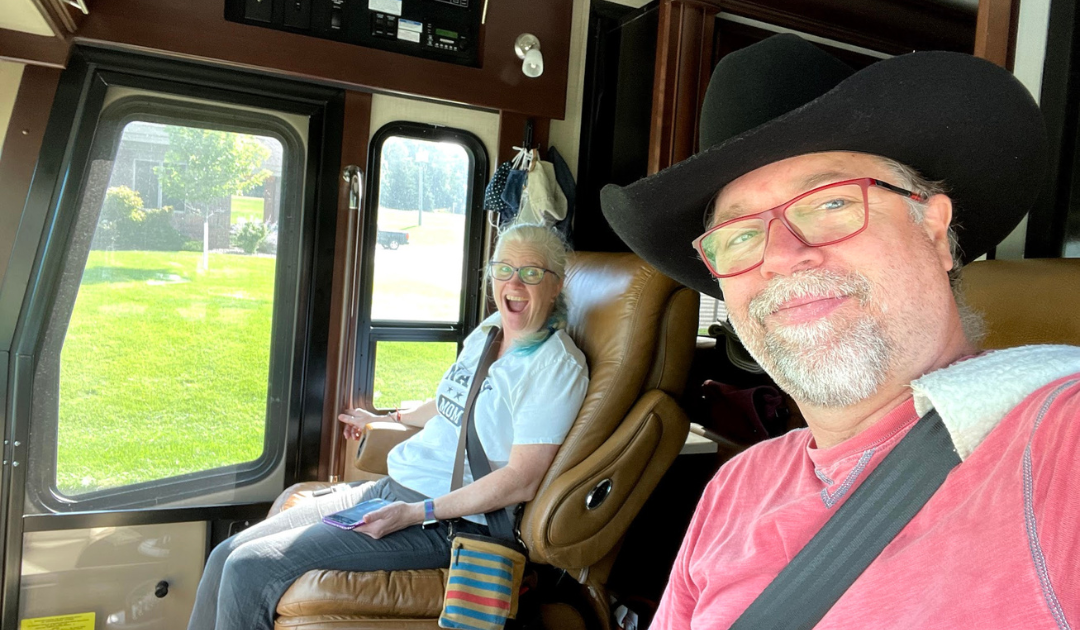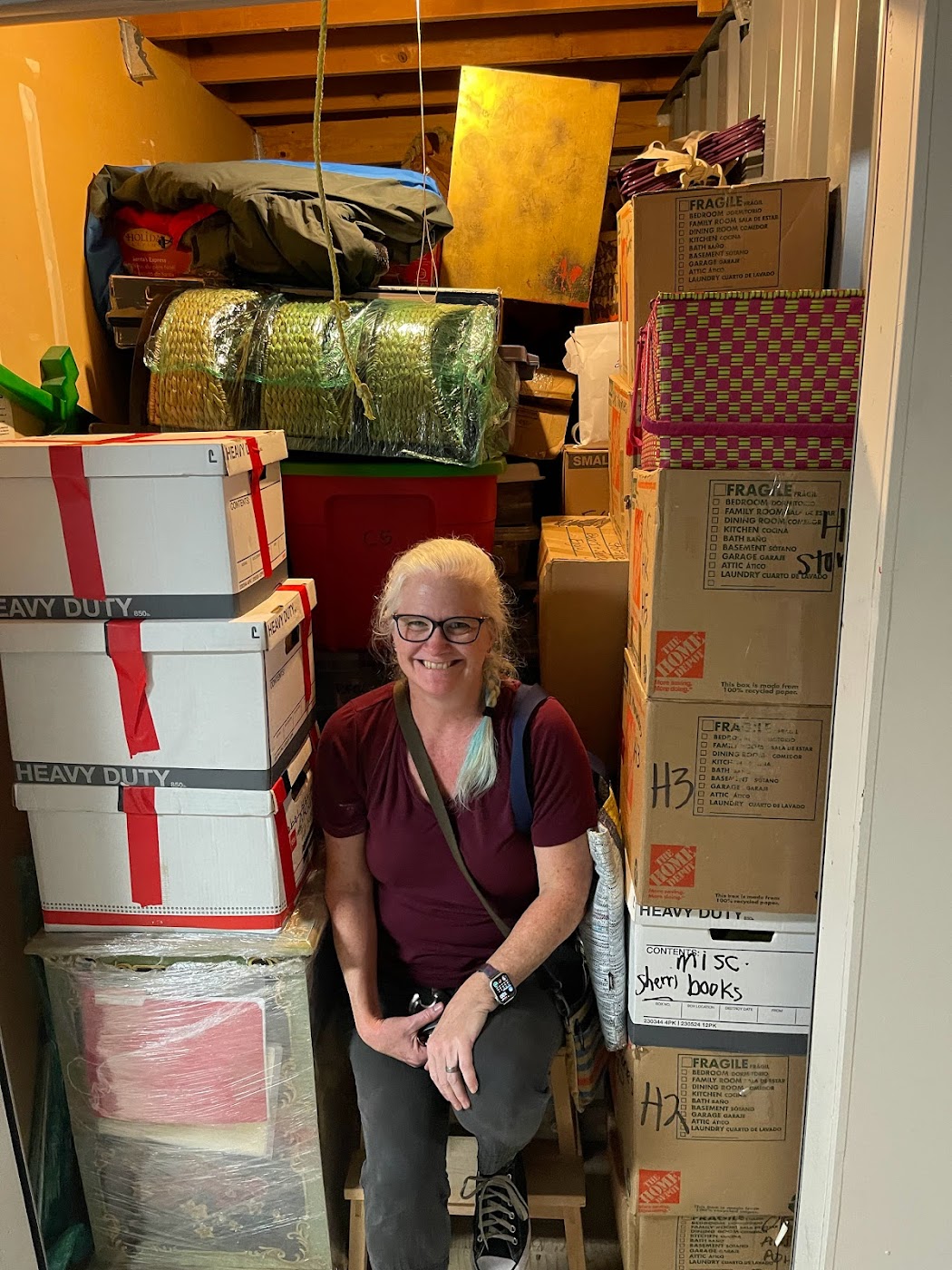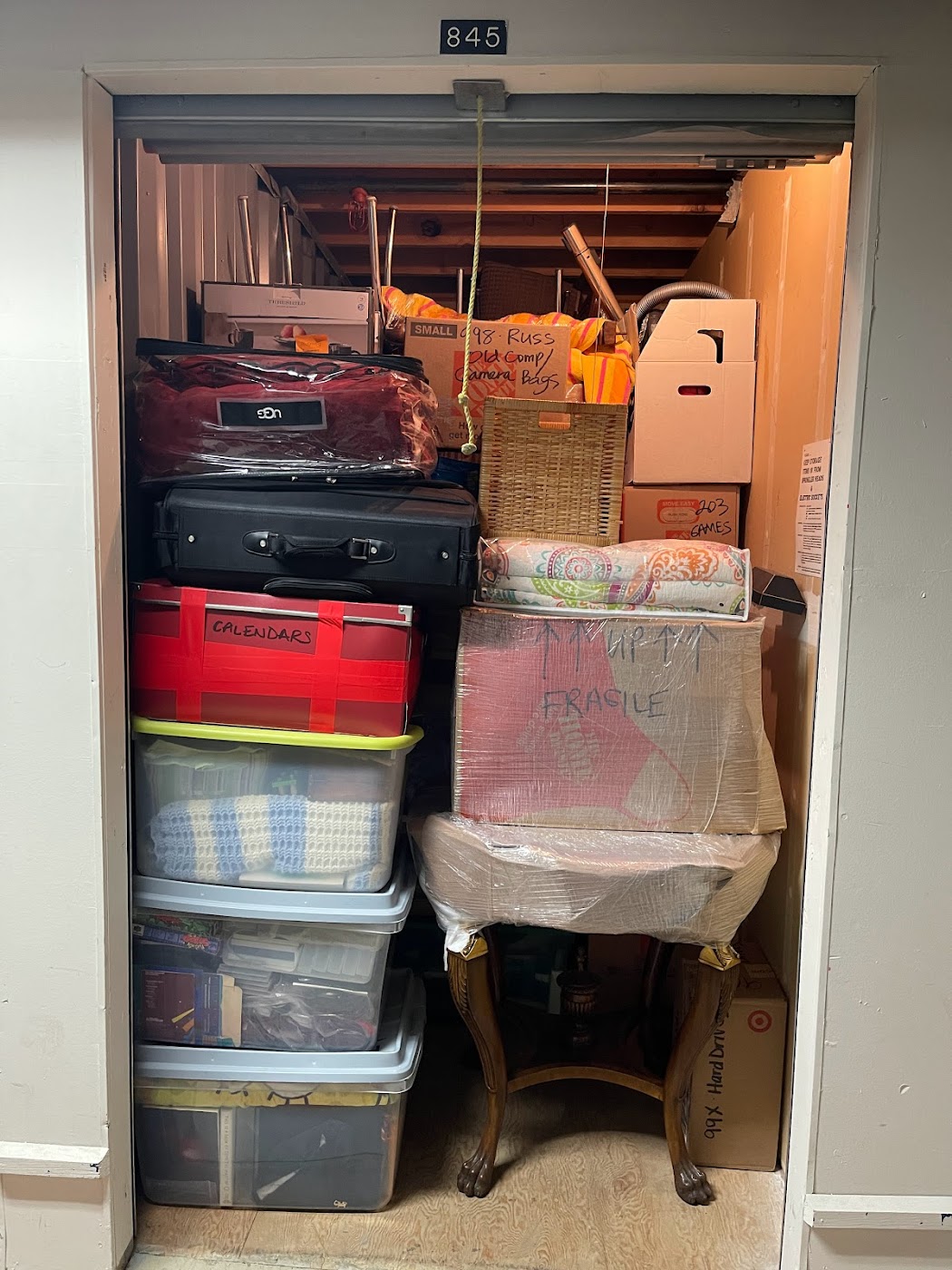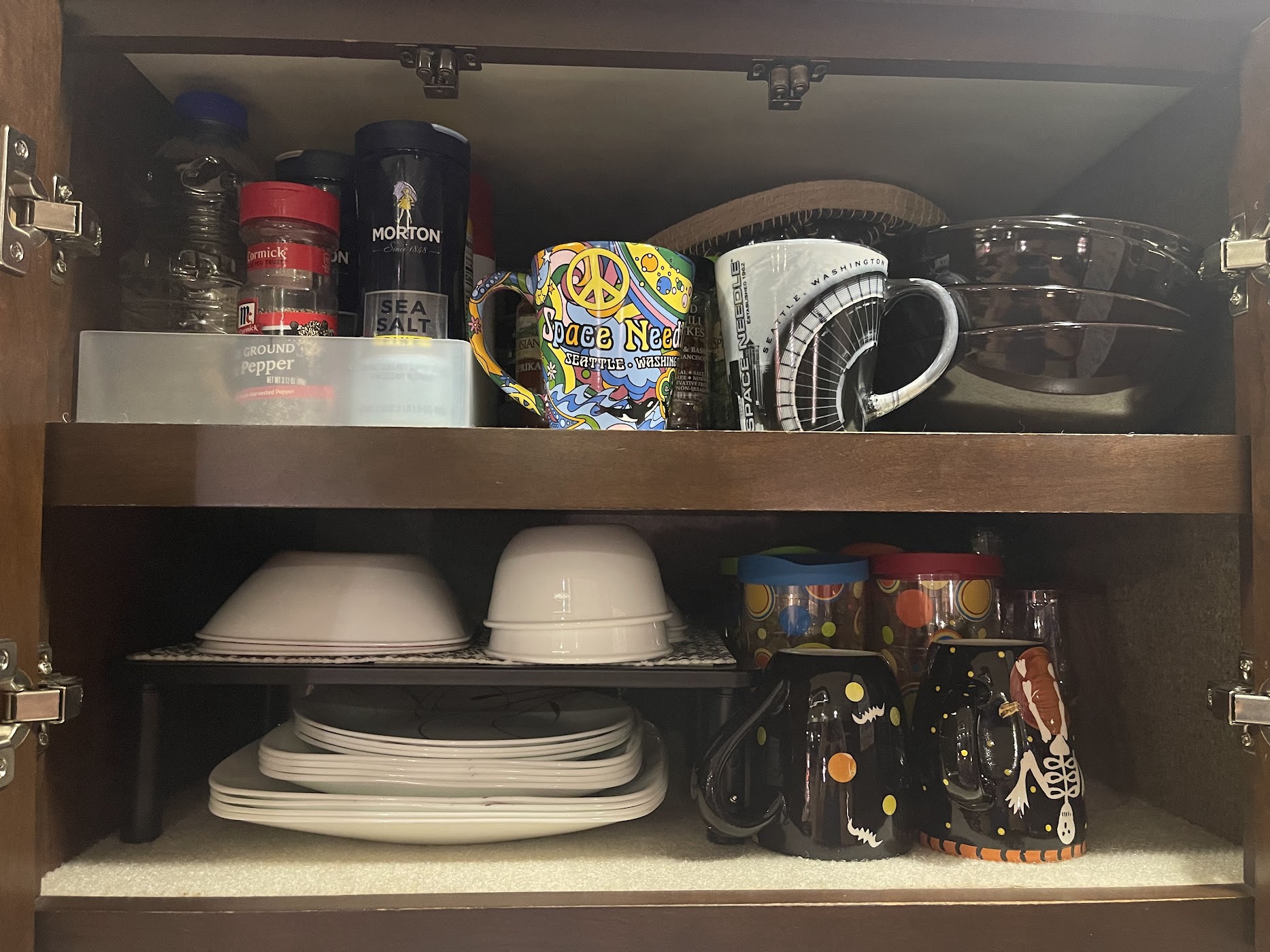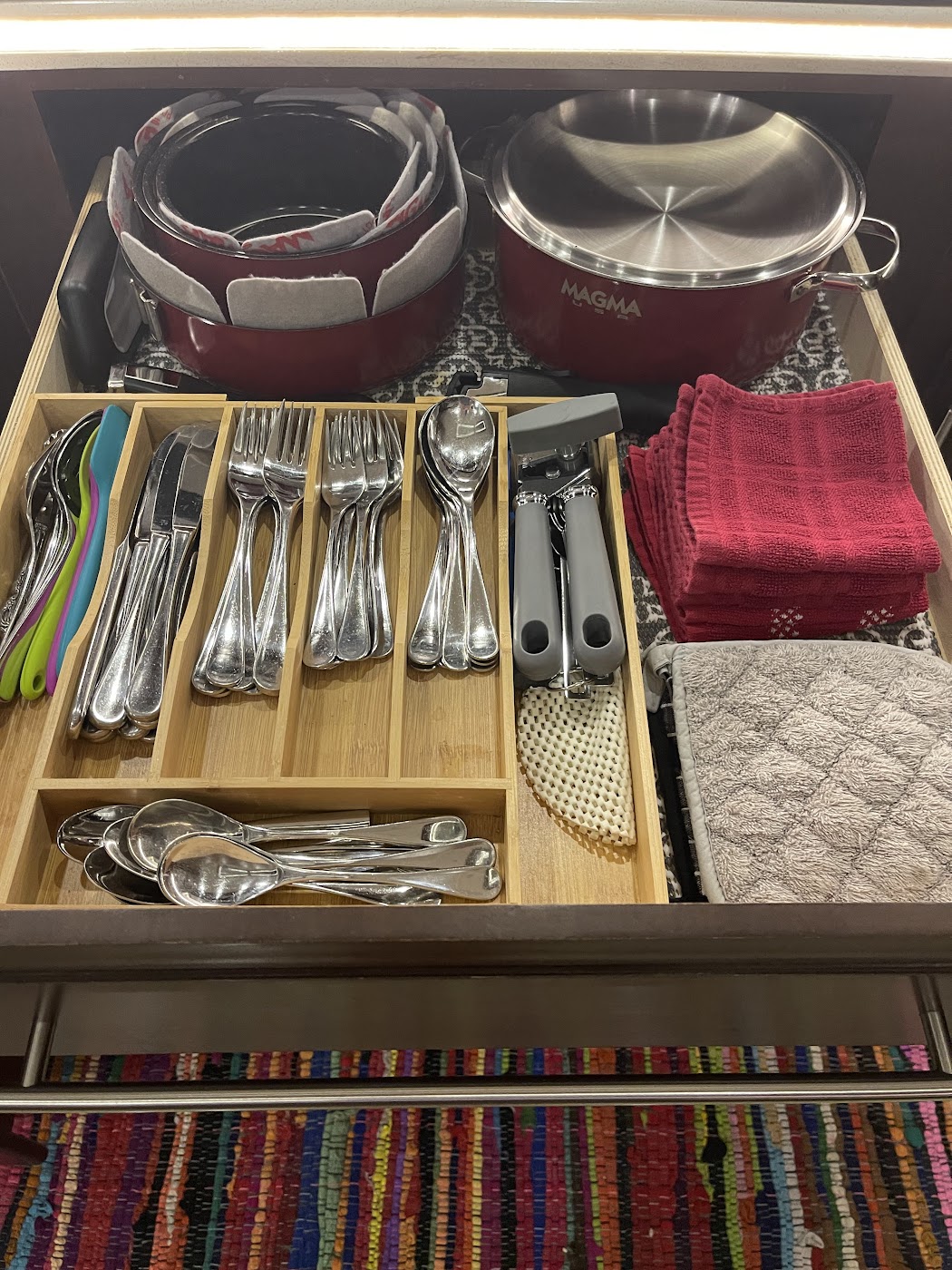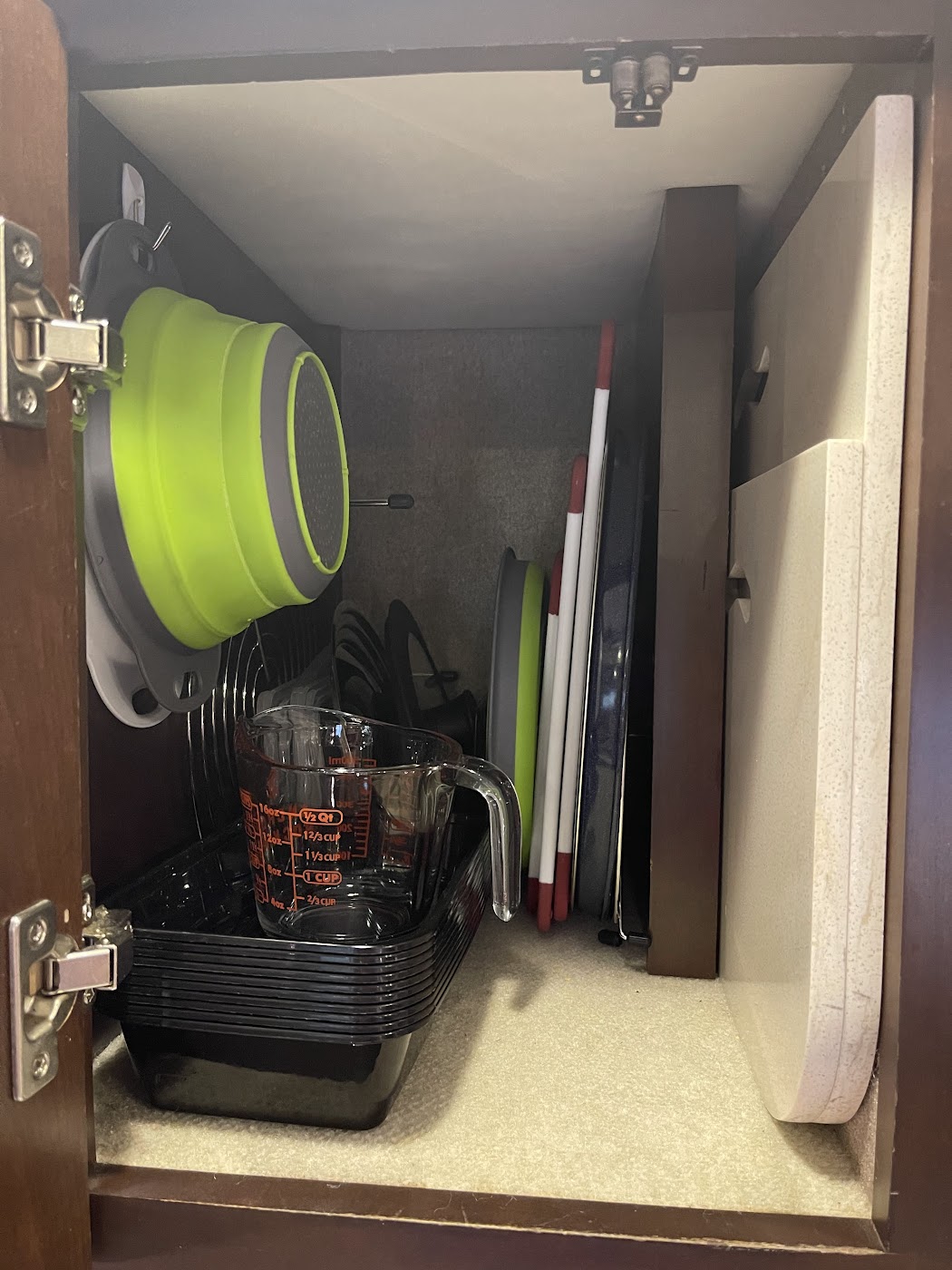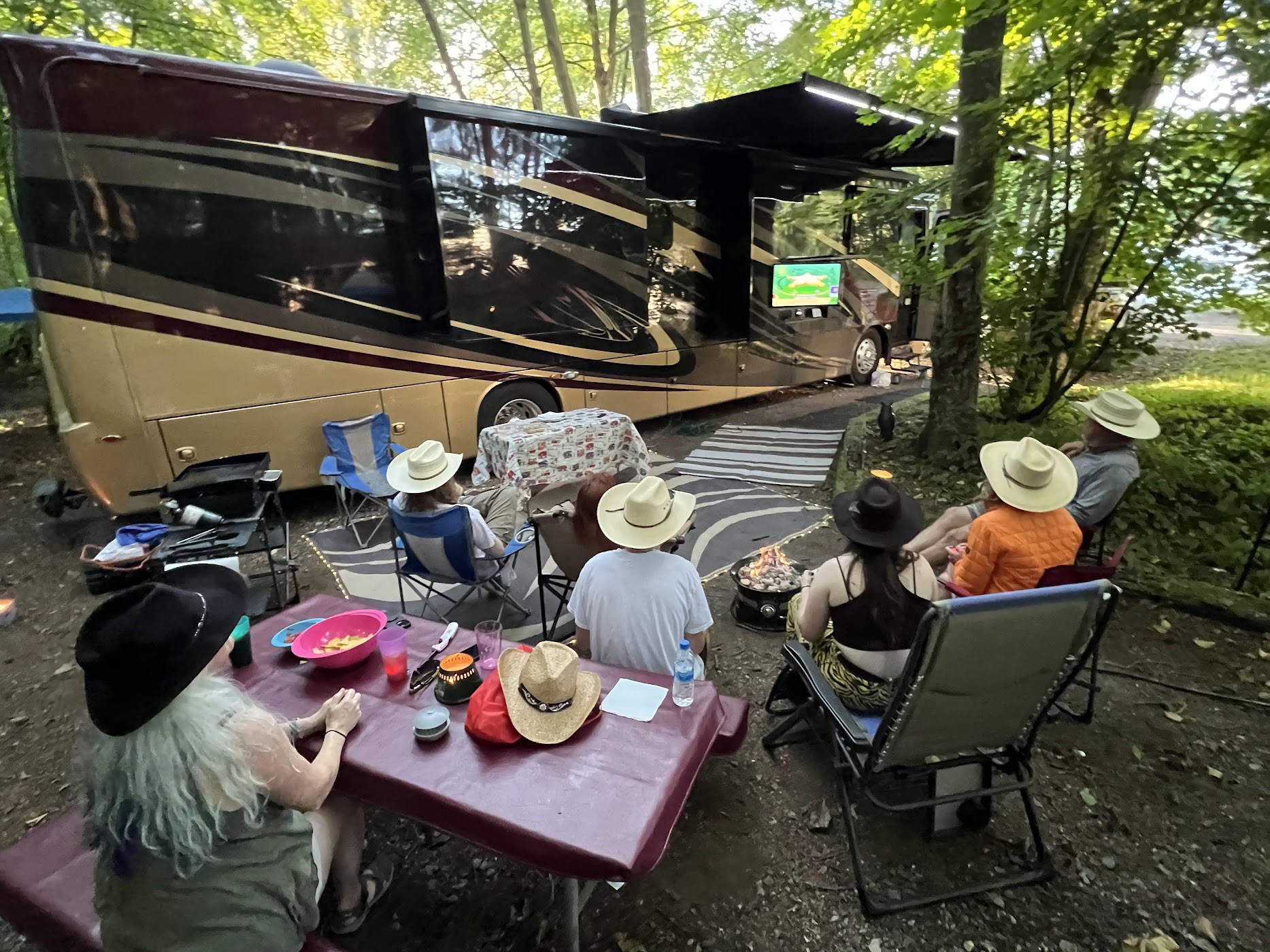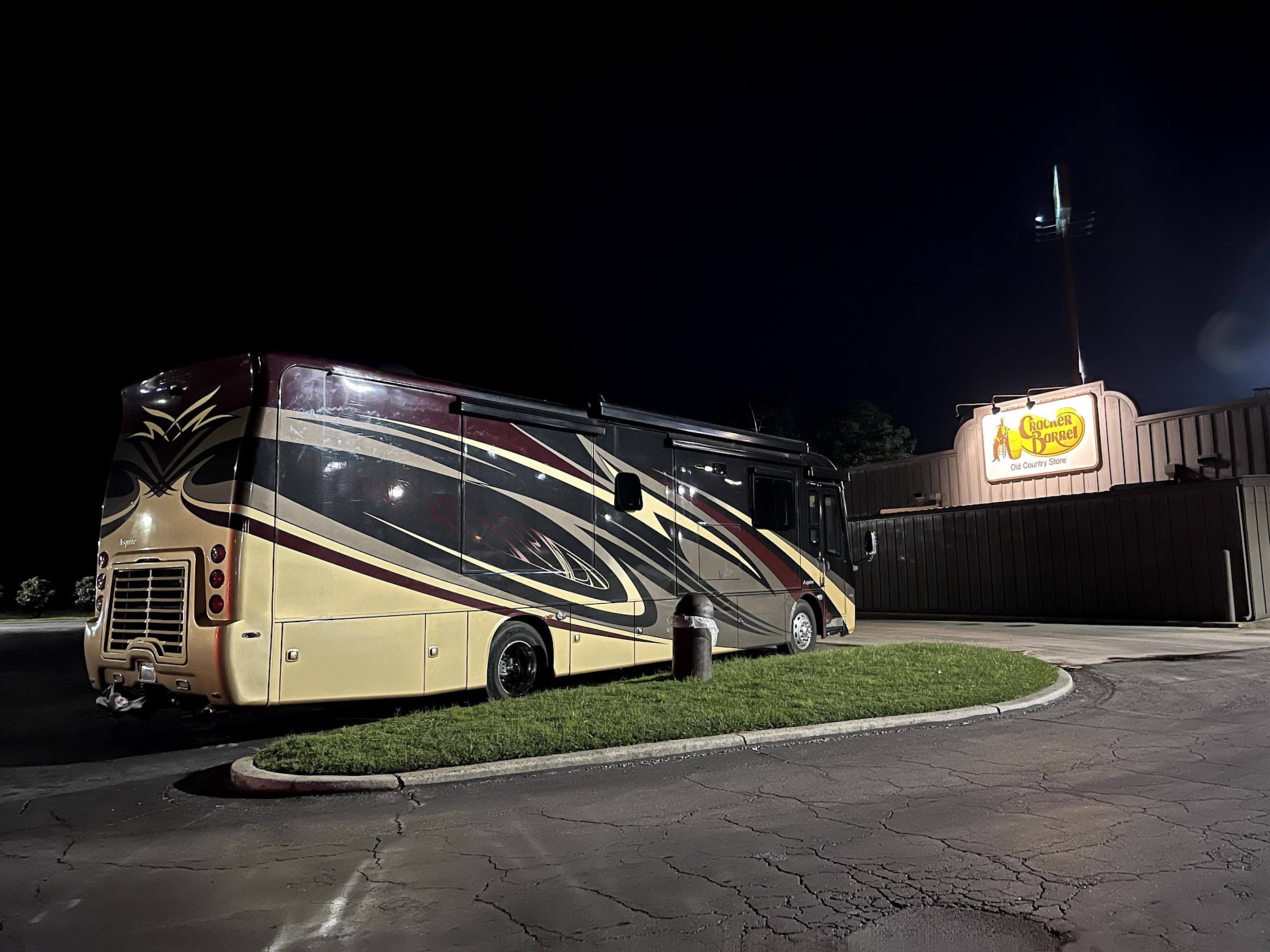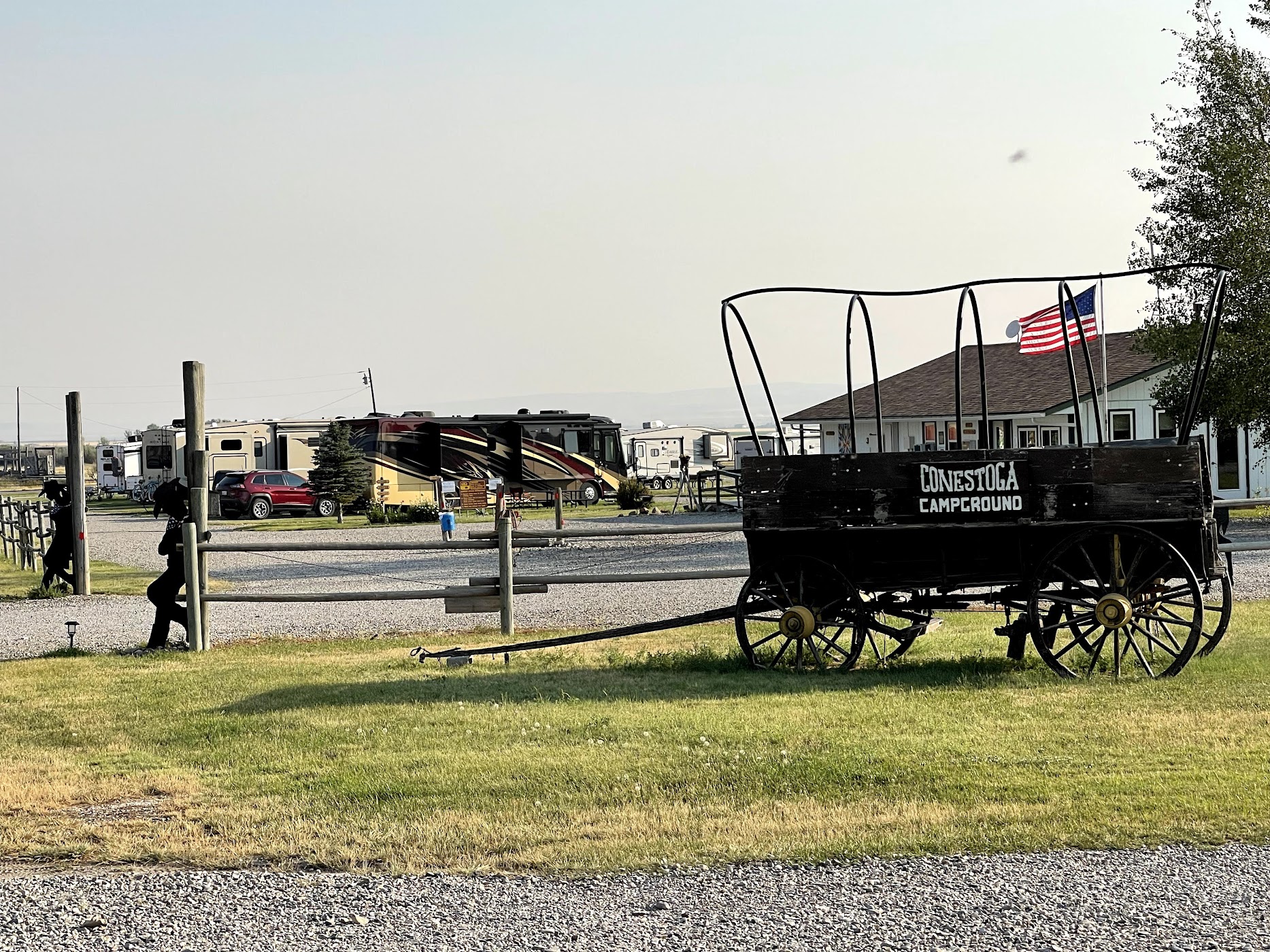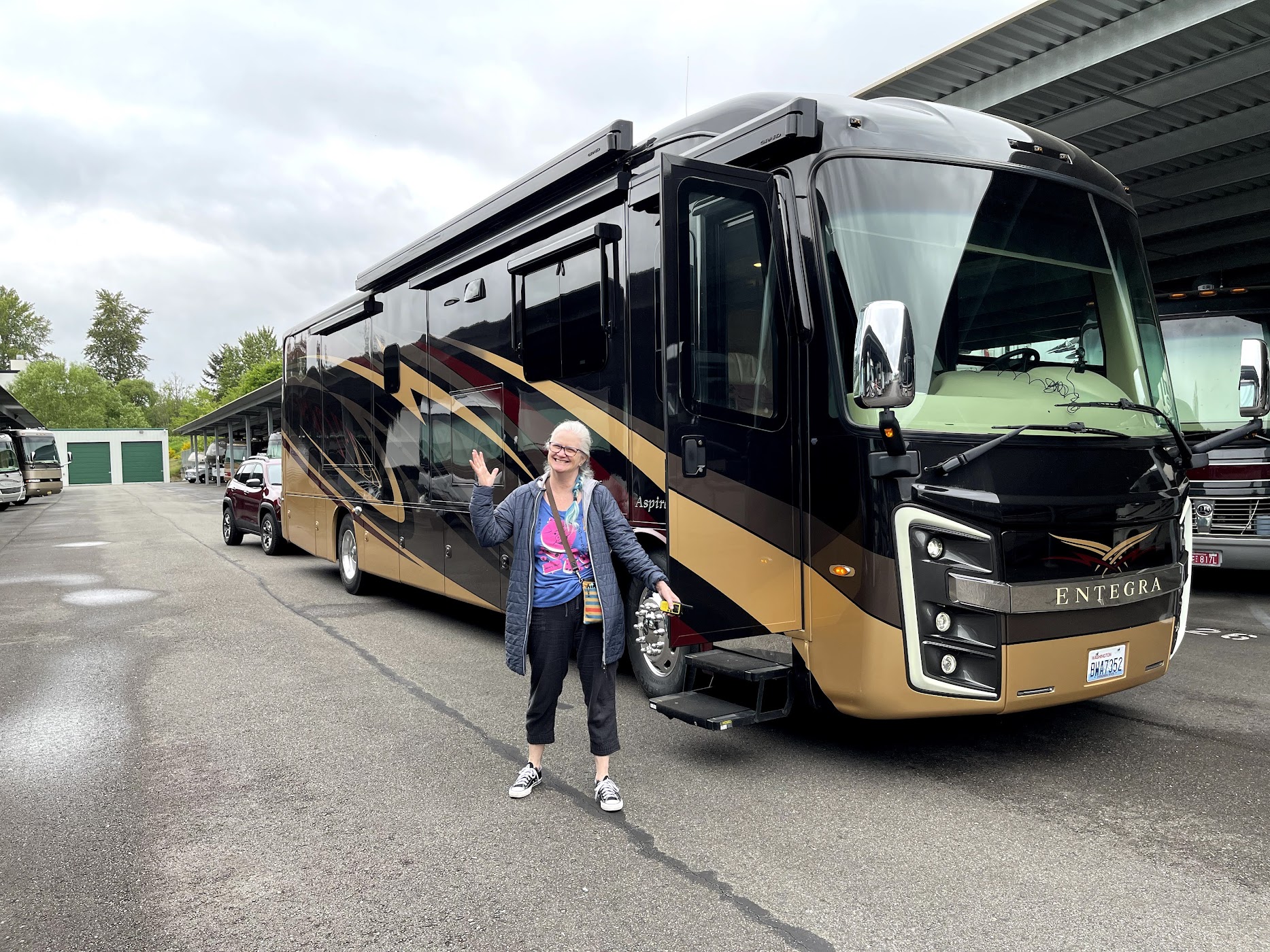sticks & bricks definition:
A regular house, condo, apartment, or dwelling on some type of permanent foundation that does not have wheels. Sticks & bricks have a physical address. Sticks & bricks are always located at the same place on the map.
If you are already the happy owner of a fabulous motorhome… or if you are a soon-to-be new owner, planning on it, or just dreaming about it…
Have you ever thought about giving up your sticks & bricks and going full-time RV?
That’s exactly what we did, two years ago, in our new-to-us 2016 Entegra Aspire. We named her Charlie-The-Unicorn RV.
People have so many questions about living, working, and traveling full time in an RV! We did, too. We had no idea how or what we were doing – the logistics of it all – when we made the decision to go full time. We figured it out, mostly in the 60 days before we took off on this exciting and unknown adventure.
And, of course, we’re still learning.
So if you are thinking, planning, dreaming, or just wondering about the logistics and transition to full-time RVing from full-time sticks & bricks, keep reading… If we can survive this adventure, you can, too! I’ll do my best to share our experience and answer those burning FAQs (Frequently Asked Questions).
12-step RV Life Checklist:
- Do you own an RV?
- Getting out of your sticks & bricks
- What to do with all your stuff?
- RV Living Space
- RV Kitchen Essentials
- Domicile & Permanent Address
- RV Financial
- Staying Connected: RV Internet
- Medical & Health Insurance
- RV Prep: Maintenance, Service & Safety
- Leaving Family
- Finding places to stay 😳
✅ 1 – Do you own an RV?
If so, and you feel confident you could live comfortably in your RV full time, proceed to Step 2!
If not, or if you want to consider other options for full-time RV living:
- Go visit, or get in touch with, a Lifestyle Specialist at any of the six NIRVC locations across the country. They can help you find the perfect starter or upgrade RV for your transition to full-time RV life.
- Purchase your full-time RV while you’re still at your sticks & bricks address, especially if you are financing any part of your purchase.
- Arrange storage and recreational-use (part-time) RV insurance while you’re in transition, but it’s all much easier at this stage than later. (You’ll change to full-time RV insurance coverage later, when you’re ready to go!)
- Start your research! Search term: “Full Time RV Lifestyle”. Google, YouTube, IRV2.com, and Facebook Groups can be your best resources, from when you’re first getting started to living full time in your RV.
We weren’t thinking about full-time RVing when we purchased our 2016 Entegra Aspire in 2020. It was a part-time escape plan for us at the time, which worked out great during the pandemic. And then…
✅ 2 – Getting out of your sticks & bricks
Decisions, decisions:
- Sell or rent your home
- Give notice on your lease, if renting
- Set your launch date!
Everyone’s situation will be different, whether you own your home or rent and how long you’ve been there. I imagine every year in place might take at least a month longer to prepare, especially if there’s family history or grown & flown children.
We had about 60 days.
Our situation was easier than most. In 2021, after 25 years building our careers and raising three children in Atlanta, GA, we had packed our almost-empty nest up in 2019, to move ‘back home’ to Seattle, WA, to take care of my mom.
We had already gone through a big move, re-organized and gotten rid of a lot of stuff. We had leased a two-bedroom condo in downtown Seattle for two years to be near my husband’s new office and to figure out where we wanted to re-settle. Half our stuff was already in storage, at that point.
Two years later (2021)… well, everything changed during the pandemic:
- We were both working from our small condo 24/7/365.
- Our college kid, who had come back home during the pandemic, was able to return to school.
- My mother passed away in January 2021.
The lease came up in May 2021, and we realized, with both of us working from home, an empty nest, and a 40’ luxury RV in storage north of Seattle… home could be anywhere. We set our full-time RV living launch date for Memorial Day: May 2021.
✅ 3 – What to do with all your stuff?
In the end, there are only three options with stuff:
- Take it with you: find a place for it in your RV.
- Store it somewhere: with family or a storage facility.
- Get rid of it: SELL – DONATE – TRASH
Even though we’d just done all of the above two years before, we had to go through it all again – this time, going from a 1,000 sq. ft. two-bedroom/two-bath condo with many shelves, cabinets and closets to our 400 sq.ft. mobile living space with very few storage spaces, sharing one RV closet and one dresser…
Pro Tip: Start early and be ruthless!
- Take inventory, create lists and spreadsheets (whatever works best for you).
- Tag everything with sticky notes: RV – STORE – SELL – DONATE – TRASH
- Start disposing immediately, whether it’s to sell, donate, or trash.
- Start living in smaller space: downsize kitchen, bedrooms, and bathrooms in your sticks & bricks to use the same number and size of cabinets and drawers in the RV. Start using those cabinets and drawers for the things you want to take with you.
- Figure out what to do with the rest: STORE – SELL – DONATE – TRASH.
FAQ: What did you do with all your stuff?
Honestly, I lived 30+ years of my adult life believing if you had to pay to store stuff, you really didn’t need the stuff – seriously!
But there I was, in Seattle, WA, after the Big Move in 2019, with ONE (1) 5×10 storage unit already full of the things we couldn’t leave behind in Atlanta, knowing we’d be buying a house again, but couldn’t fit in the condo:
Excerpts from Sherri’s Countdown Journal:
— 54 DAYS TO FULL-TIME RV LIVING
We are going to pay for storage this first year, and probably for the rest of our lives. Or at least until our kids turn 40 and make the pilgrimage to the storage facility to reclaim the treasures and relics of their youth. Just like we did. An “Adulting 101” rite of passage. Too much stuff.
In fact, that’s where I’m headed today: our storage unit! I’m going to spend the morning with our existing storage, inventorying and organizing, hopefully pulling out some things we haven’t missed in two years and getting rid of it. To have room for more stuff we won’t see for the next two years…
— RV-9 (NINE) DAYS TO FULL-TIME!!!
We are now the proud renters of TWO (2) 5×10 storage units in Seattle, WA
Move to Seattle – Storage Unit #1
Storage Unit #2
✅ 4 – RV Living Space
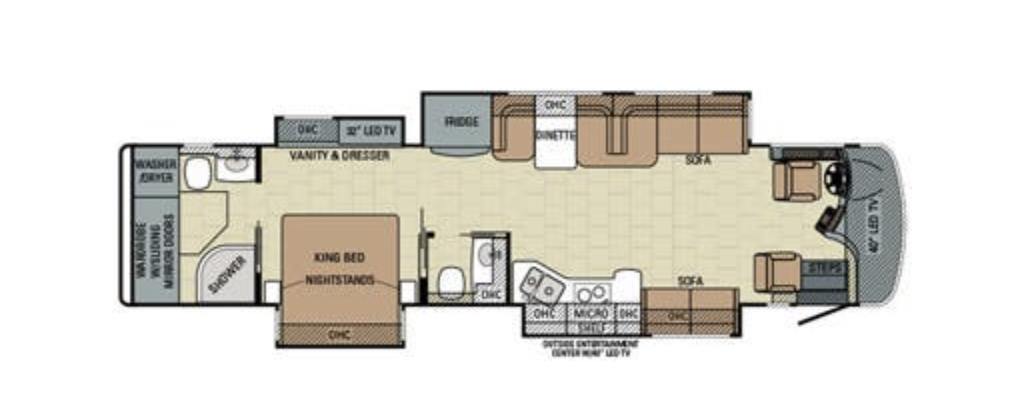
The floorplan of our 2016 Entegra Aspire 40P
FAQ: What can you take with you when you live full time in an RV?
Well, that’s a puzzle, and puzzles can be fun:
- Get a floorplan schematic of your RV, if you can. You might be able to find one online. Or make your own.
- Measure your RV living spaces, especially drawers and cabinets and closets. Diagram where things might go.
- Remember to measure vertical space and walls. It’s amazing how much extra storage space you can create with Command™ strips and hooks.
- Make room in your RV for things from home you’ll appreciate on the road: artwork and photo frames you can put on the walls (with Command™ strips); throw pillows & blankets; small decorative touches (preferably unbreakables).
- Visit and take your RV out every chance you get before your launch date – take stuff up, bring stuff back. (It’s an endless cycle, even after you launch.)
— COUNTDOWN: 52 DAYS TO FULL-TIME RV LIFE
We went up to the RV (at the storage facility) yesterday to spend some time on maintenance, planning, and organizing our very small space for full-time living & working. (I managed to find space to take a dozen books with me: 12 books!)
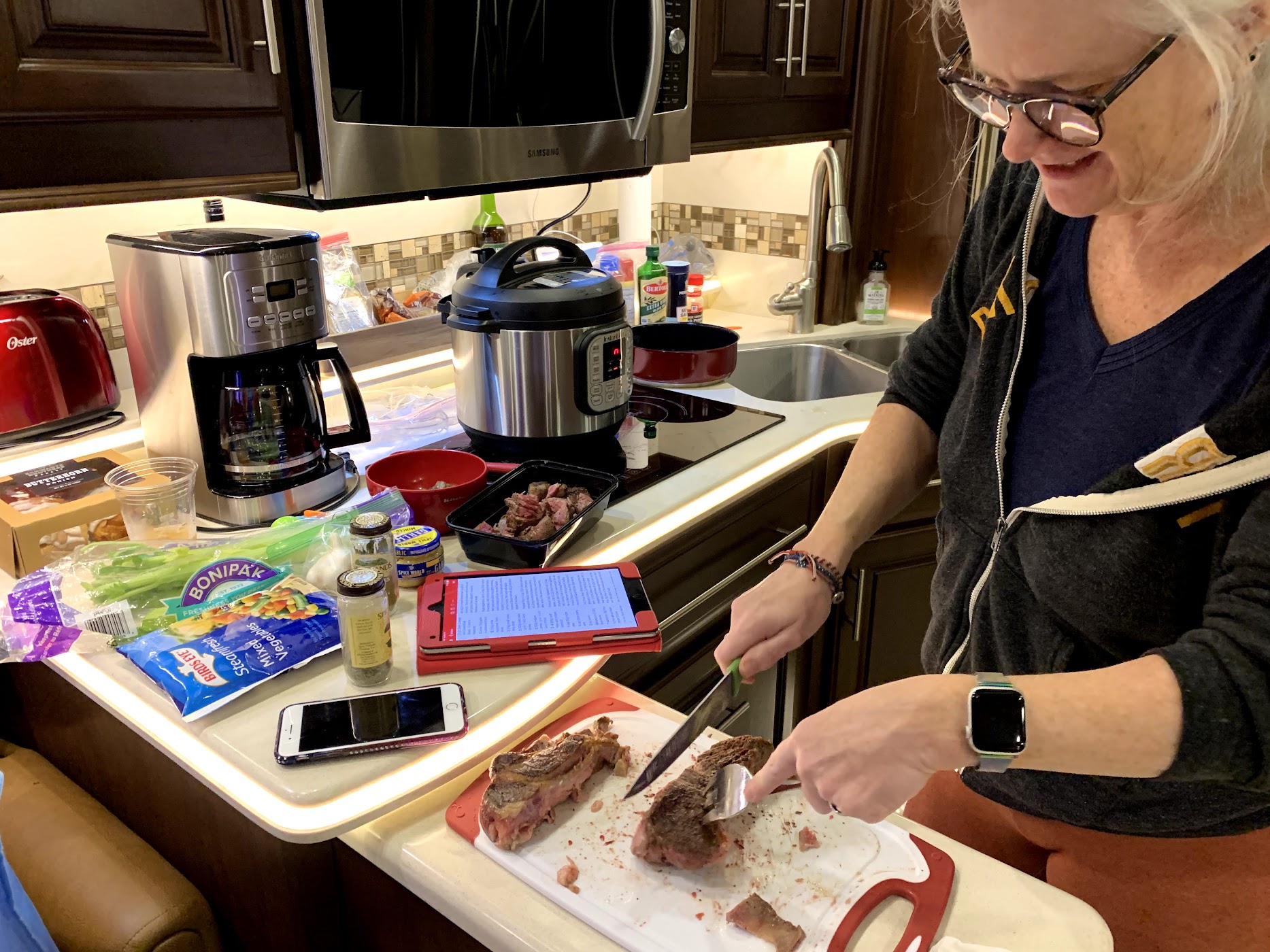
✅ 5 – RV Kitchen Essentials
FAQ: How do you outfit the kitchen for full-time RV living?
Trade-offs will be necessary:
- RV dishes: You won’t need or want 16 place settings of heirloom china and crystal in your rolling earthquake of an RV. You need a nice, simple set of durable dishes that will stack well and not take up too much space. For two adults, we bought a 4 place setting kit of Corelle dinnerware. I love it!*
- Silverware: Again, you won’t need or want your entire utensil drawer from home. You need enough, but not too much. We brought eight of each: knives, forks, soup spoons, teaspoons, and a couple of servers, which all fit nicely in the wooden organizer tray that fits in the drawer space available.
- Same goes for all those kitchen appliances, gadgets, cooking utensils, mixing bowls and serving dishes: Bring all your unbreakable favorites to the RV, find secure space for as much as you can. Take the rest back home to SELL – DONATE – TRASH.
- Paper Plates, Plastic Utensils & Red Solo Cups (I prefer clear, but hey, you do you) for casual outdoor dining and boondocking.
Our favorites for RV kitchen & full time living: New set of nested pots & pans for induction stovetop! – Collapsible colanders! – Nested, colorful melamine bowls for food prep and serving! – Standard-sized MEAL PREP (brand: goodcook) rectangle storage containers with lids for storing or serving anything and everything!
*You might notice, in the pictures above, that I’ve bent and broken a few of my own suggestions. I do love my Corelle dishes, but I also missed the big stoneware bowls we use for pasta, salads, and bowl meals. So I went back to storage and brought four stoneware bowls with us. And four of our favorite coffee mugs. So far, so good.
✅ 6 – Domicile & Permanent Address
Domicile (Merriam-Webster)
Legal: a person’s fixed, permanent, and principal home for legal purposes
FAQ: How do you get mail when you’re RVing full time?
Choosing and establishing your domicile and permanent address can be one of the trickiest steps in the transition from sticks & bricks to full-time RV living. You can only have one primary address at a time, for legal reasons, which include:
-
- Vehicle Registrations & Driver’s Licenses
- Insurance & Financial Accounts
- Voter Registration
- Taxes: Federal, State & Local
- School, Employment & Health Insurance, if applicable
There are many reasons full-time RVers might choose to change their domicile state and permanent address when they sell or leave their sticks & bricks. Some states are more favorable for full-time RV living, for legal and tax purposes.
This is a topic you definitely need to research and make decisions to fit your own situation, with professional legal and/or tax advice as needed.
We kept things simple and kept our domicile in Washington State. We have a lease agreement with a trusted family member and use their address for domicile and mail delivery. We’re there at least once a year, when we’re in Washington. They receive our mail and send a packet with mail, or whatever we need, whenever we’re in a place long enough to receive a package.
It was a relatively simple process for us to establish domicile and do all the things:
✔️ Mail forwarding & permanent change of address with U.S.P.S.
✔️ Vehicle registrations (RV and automobiles)
✔️ Driver’s Licenses
✔️ Voter Registrations
✔️ New Library Card! 🤓 (Did you know you can borrow ebooks and audiobooks online from your local library, anywhere you are?)
— COUNTDOWN: 40 DAYS TO FULL-TIME RV LIVING!
I still have moments (lots of moments) when I can’t believe we’re actually doing this…
✅ 7 – RV Financial
Related to domicile and permanent address considerations, financial organization is very important as you prepare for full-time RV living. Whether you are sharing a mailbox with family or using a mail forwarding service, you’ll want to move online as much as possible to cut down on paper mail:
- Manage all banking and financial transactions online.
- Sign up for email billing and statements.
- Arrange automatic payments for recurring expenses.
- Review credit reports, close accounts, stop mail as much as possible.
- Cancel memberships, subscriptions and auto-shipments (i.e. Amazon Subscribe & Save).
→ Keep physical copies of current vehicle registrations and insurance documents with you, easily accessible in case of emergency.
→ Organize and keep your financial information and important documents up-to-date and easily accessible online in a secure folder or directory you can access from any computer.
→ Your family or designated legal representative needs to know how to access information, if something happens to you. If you have a safe deposit box or rented storage units, make sure you leave keys and access information with someone you trust.
✅ 8 – Staying Connected: RV Internet
Unfortunately, Hubs and I are not retired or independently wealthy. The pandemic offered us a unique opportunity to work from home. And then we realized, with a big Class A Motorhome, “home” could be anywhere with good internets!
FAQ: What do you do for Internet?
(This was our #1 Most Frequently Asked Question, in the beginning.)
Hubs works for a large technology company. He is online full-time, all day, every weekday, Zoom conferencing with his team and clients all over the world. Reliable internet access is critical for his job and our continuing ability to live and travel full time in our motorhome.
Again, the situation and requirements will be different for everyone on the road. We needed redundant data plan coverage from the Big Three cellular networks, along with equipment to network it all together and automatically switch back and forth according to the strongest cell signal wherever we happen to be across the country.
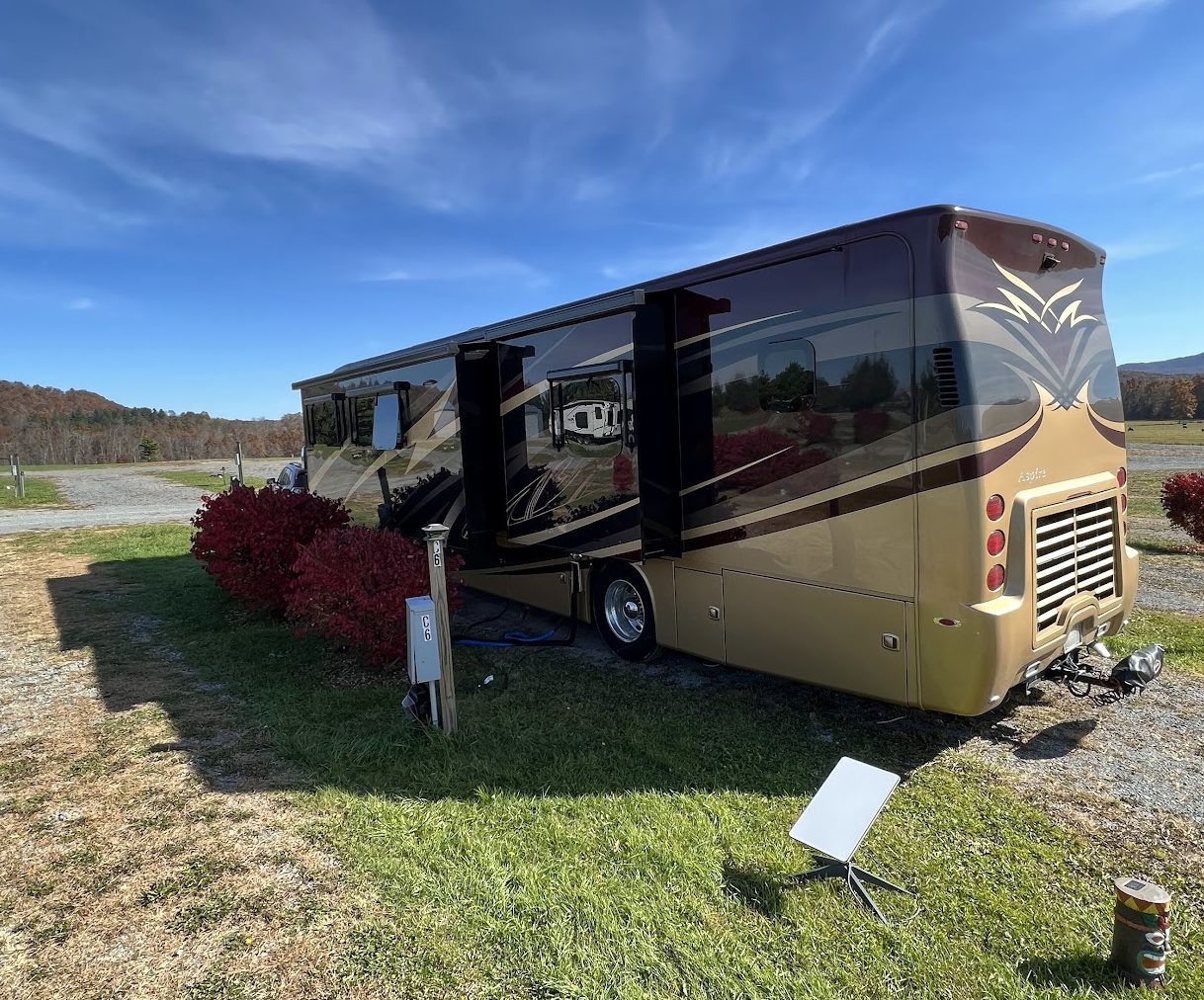
Last summer, while we were in Washington, we added Starlink RV, with the Starlink “Dishy” (satellite dish) set up outside the RV, leading to the current #1 Most Frequently Asked Question:
FAQ: How do you like Starlink RV?
Answer: We like it just fine for regular household internet, streaming services, and back-up when there is good satellite visibility. Turns out, it’s not so great for Zoom. Starlink service sometimes drops in and out as the satellites go by. You normally wouldn’t notice, but it can cause the dreaded freeze frame on Zoom, which is definitely not great for online video conferencing.
—> If you’re trying to figure out your internets for full-time RV living, check out Internet on the Go, one of NIRVC’s trusted RV Aftermarket Partners for added safety, protection, and convenience.
✅ 9 – Medical & Health Insurance
There are many things we are still learning about full-time medical and health insurance. As far as prep for full time RV living:
- Health Insurance should be part of your domicile decision, depending on employment, Medicare eligibility, or private insurance/state program requirements.
- Schedule annual medical and dental appointments with plenty of time before your launch date, to allow for follow-ups.
- Most full-time RV people we’ve met schedule time to be back home for annual appointments with their regular doctors. (Including us: We have reservations in June in a campground close to our medical center in Seattle to be nearby for already-scheduled appointments.)
- It is always a good idea to know where the local emergency services and urgent care clinics are located, wherever you are staying. Many campgrounds include that information in their campground guide. Keep those handy for reference, and to have your current address available, in case of emergency. (And for mailing address and package delivery. But that’s beside the point here. 😉)
✅ 10 – RV Prep: Maintenance, Service & Safety
Just like your physical health and safety, your RV needs to be ready to go full time, too:
- Schedule full RV service and maintenance for all systems before you go. The more you can take care of before you go, and keep up with annual service appointments, the better. Of course, things will always happen along the way…
- Learn as much as you can about basic RV maintenance and routine services you can take care of yourself. Some excellent resources for this include:
→ NIRVC Angie’s RV 101 Video Series on YouTube
→ AIM Club Collected Resources To Make Your RV Ownership More Enjoyable
- Assemble an emergency road kit from your chassis manufacturer to have spare filters, fuses, belts, and liquids that you might need in the event of a breakdown on the road. Remember to carry necessary tools and safety equipment for emergency repairs.
- Finally, just as you would in your sticks & bricks, make sure you have adequate safety features in place to protect your home and lives: smoke detectors, fire suppression, and security systems.
✅ 11 – Leaving Family
Getting ready to go, I struggled with the concept of Home Base. Of not being Home Base for our family while living and traveling in our RV. The worry of not being there for my kids, with no place for them to visit, or to stay, if needed.
We have three grown and nearly-grown kids: ages 28, 25 & 22. And, truth be told, they’re all over the U.S. right now, too, in their careers, and relationships, and school: Hawaii, Missouri, and Washington State.
No grandbabies yet (and that might change everything, right?). This is a time in our lives when our kids don’t need us, or necessarily want us around full time, for a few years, especially after the two years of close living with our college student.
It was hard to prepare for this. I cried a lot in those last 60 days, saying goodbye to family and friends in Washington, during the pandemic, when we couldn’t even get together, anyway.
But I learned some things in the last two years on the road, and I’m reassured to discover we’re closer, in some ways, by traveling the country full time in our big RV:
- We’ve actually seen our loved ones — our kids, extended family, and friends — more now than we would have at home in Seattle. Even the Hawaii kid, who came and stayed with us for a week for a wedding in Atlanta! (We rented an AirBnB, while Charlie-the-RV was in for service at NIRVC – Atlanta.)
- With everybody’s busy lives and schedules, and the difficulties of air travel recently, it’s easier for us to travel in the RV and stop in to see our people all over the country. We stay at a campground nearby and it works out great!
- Thank goodness for technology and the good old-fashioned telephone, er, cellphone, for connection.
- We’ve enjoyed Zoom holidays, check-ins, and fun family game nights from four different time zones.
- Every Sunday, I text a proof of life picture to our kids and let them know where we’re staying.
The kids are all okay. And we are, too.
✅ 12 – Finding places to stay
Finding campgrounds and places to park our 40-foot RV was one of my biggest worries from the beginning. This literally kept me up at night, months before making the leap to full-time. It can still be a challenge. I’m not, by nature, a long-term planner.
We’ve managed to stay at least 60 days ahead of our schedule. Some full-time RV people plan and reserve a year or more in advance, which you have to do in more popular areas and seasons.
→ We tend to travel where and when people aren’t, to avoid the crowds.
FAQ: Have you ever stayed in a WalMart parking lot?
We have never stayed overnight on a WalMart parking lot, but we would, if we had to!
We have always found a place to stay, even if it was a Cracker Barrel parking lot in Mississippi one night early in our adventure … and a BJ’s parking lot in Florida one night, when we were caravan-ing with friends and had a breakdown.
In general, we stay at quirky, private campgrounds and nice resorts across the country, for a week or two at a time. We have an RV property we stay at in Florida for a month or two during the winter and a membership campground in Washington where we stay a month or two during the summer.
One of our quirky, wonderful campgrounds – White Sulphur Springs, Montana
FAQ: How much does it cost to live in an RV full time?
We’re still figuring that out, after two years on the road. One of the biggest expenses, traveling full time in the RV, is campground and resort fees.
We have paid from $0 to $180 per night, for different types of campgrounds. A sampling of rental fees from different categories:
- Most expensive (so far): “Oceanfront” “Resort” in Oceanside, CA – $180 per night 😳
- Luxury Motor Coach Resorts – so far, less than $100 per night, but these super-nice ownership/rental resorts can get pricey.
- Luxury RV Resorts: Sun Resorts & upscale KOA Resorts – $75 – $150 per night.
- “Holiday Inns” of campgrounds: KOA Journey/Holiday, Good Sams – $50 – $90 per night. Clean, usually smaller, fewer amenities.
- Quirky, privately-owned campgrounds: Our Favorites! $20 – $50 per night.
- RPI (Encore/Thousand Trails)/Coast2Coast Membership Campgrounds – $10* per night. *But we do pay annual membership for these programs, about $150/year each.
- Home Membership Park – $0 per night – 2 weeks in / 1 week out (to RPIs nearby). We purchased lifetime membership for about $4,000 in 2021, which included cross country RPI and Coast2Coast memberships. Our home park was bought out the very next day by Sun Resorts. We pay annual renewal of about $500 for privileges at that one location (Blaine, WA).
I have learned there is always a place to stay. Somehow it all works out.
— ZERO (0) DAYS TO GO RV FULL-TIME:
TODAY is the day! Hubs & I are moving into the RV FULL TIME!!! I am excited. Still a little… 🤪🤪🤪
So here we go.
May 2021: Full Time RV! Leaving our storage facility for the last time!
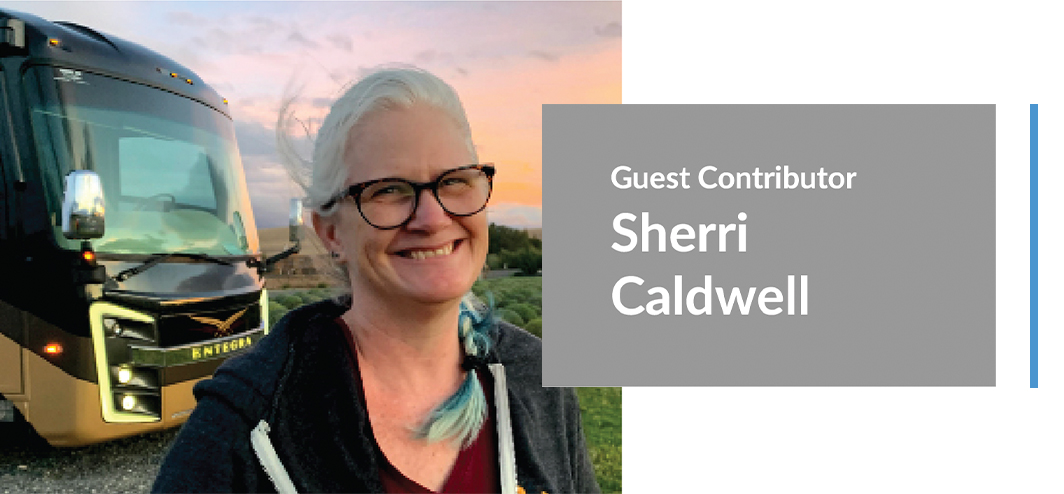
Sherri Caldwell is the founder of BooksAndTravelUSA.com – Full-time RV Travel Blog & Book Club/U.S. Literacy Project. With her husband, Russ, she is currently living, working, and traveling full-time in their 2016 Entegra Aspire: Charlie-The-Unicorn RV.

